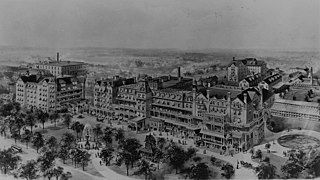
Kurt Georg Kiesinger was a German politician who served as the chancellor of West Germany from 1 December 1966 to 21 October 1969. Before he became Chancellor he served as Minister-President of Baden-Württemberg from 1958 to 1966 and as President of the Federal Council from 1962 to 1963. He was Chairman of the Christian Democratic Union from 1967 to 1971.

Oberursel (Taunus) (German:[oː.bɐ.ˈʊʁ.zl̩] ) is a town in Germany and part of the Frankfurt Rhein-Main urban area. It is located to the north west of Frankfurt, in the Hochtaunuskreis county. It is the 13th largest town in Hesse. In 2012, the town hosted the 51st Hessentag state festival.

Wesel is a city in North Rhine-Westphalia, Germany. It is the capital of the Wesel district.

Bad Godesberg is a borough of Bonn, southern North Rhine-Westphalia, Germany. From 1949 to 1999, while Bonn was the capital of the Federal Republic of Germany, most foreign embassies were in Bad Godesberg. Some buildings are still used as branch offices or consulates.

Bad Harzburg is a spa town in central Germany, in the Goslar district of Lower Saxony. It lies on the northern edge of the Harz mountains and is a recognised saltwater spa and climatic health resort.

Erich Mende was a German politician of the Free Democratic Party (FDP) and Christian Democratic Union (CDU). He was the leader of FDP from 1960 to 1968 and the vice chancellor of Germany from 1963 to 1966.

The Battle Creek Sanitarium was a world-renowned health resort in Battle Creek, Michigan, United States. It started in 1866 on health principles advocated by the Seventh-day Adventist Church and from 1876 to 1943 was managed by Dr. John Harvey Kellogg.

Winsen (Luhe) (German pronunciation:[ˌvɪnzn̩ˈluːə] ) is the capital of the district of Harburg, in Lower Saxony, Germany. It is situated on the small river Luhe, near its confluence with the Elbe, approx. 25 km southeast of Hamburg, and 20 km northwest of Lüneburg.
A civilian internee is a civilian detained by a party to a war for security reasons. Internees are usually forced to reside in internment camps. Historical examples include Japanese American internment and internment of German Americans in the United States during World War II. Japan interned 130,000 Dutch, British, and American civilians in Asia during World War II.

Bad Zwesten is a municipality in the Schwalm-Eder district of Hesse, Germany.

Bad Sooden-Allendorf is a spa town in the Werra-Meißner-Kreis in Hesse, Germany.
Ilag is an abbreviation of the German word Internierungslager. They were internment camps established by the German Army in World War II to hold Allied civilians, caught in areas that were occupied by the German Army. They included United States citizens caught in Europe by surprise when war was declared in December 1941 and citizens of the British Commonwealth caught in areas engulfed by the Blitzkrieg.

The Federal Ministry for Economic Affairs and Climate Action, abbreviated BMWK, is a cabinet-level ministry of the Federal Republic of Germany. It was previously known as the "Ministry of Economy". It was recreated in 2005 as "Ministry of Economics and Technology" after it had previously been merged with other ministries to form the Federal Ministry for Economics and Labour between 2002 and 2005. The ministry is advised by the Council of Advisors on Digital Economy.

Georg Preuß was a mid-ranking commander in the Waffen-SS of Nazi Germany during World War II. He was a convicted war criminal.

Wenzel Jaksch was a Sudeten German Social Democrat politician and the president of the Federation of Expellees in 1964 to 1966.

Rudolf Rahn was a German diplomat who served the Weimar Republic and Nazi Germany. As a member of the Party, and as Plenipotentiary of the Italian Social Republic in the closing stages of the Second World War, he was arrested and held at Nuremberg as a potential war criminal, but he was released in 1949 and deemed to be denazified in Class V (exonerated).

The French occupation zone in Germany was one of the Allied-occupied areas in Germany after World War II.

The American occupation zone in Germany, also known as the US-Zone, and the Southwest zone, was one of the four occupation zones established by the Allies of World War II in Germany west of the Oder–Neisse line in July 1945, around two months after the German surrender and the end of World War II in Europe. It was controlled by the Office of Military Government, United States (OMGUS) and ceased to exist after the establishment of the Federal Republic of Germany on 21 September 1949, but the United States maintains military presence across Germany.

Geraldine de Courcy was an American writer, music critic, and translator. During World War I she was recognized for providing aid to British internees at the Ruhleben internment camp in Germany. She was hired by the Office of Naval Intelligence in Bern, Switzerland and Berlin, Germany, and was the chief Berlin music critic for the publication Musical America. She wrote a definitive biography of Niccolò Paganini, published in 1957.






























